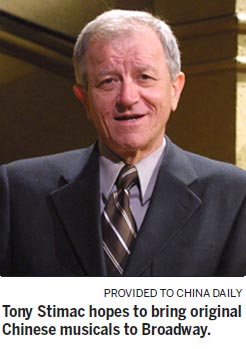For 15 years, Tony Stimac ran New York's Musical Theater Works, developing 60 original musicals.
Most productions were the work of first-time writers, six were staged on Broadway, six off-Broadway and 24 toured the United States.  The company boasted 22 rehearsal studios and had New York University send students to do workshops.
The company boasted 22 rehearsal studios and had New York University send students to do workshops.
"I liked helping the young writers to figure out what they were trying to do and make their shows as successful as possible," Stimac says.
His passion for, and dedication to, creating new musical works did not go unnoticed. One day he received a phone call from Don Frantz, then a Disney producer and director, who asked if he would like to turn the Disney version of the story Beauty and the Beast into a musical. Stimac accepted the challenge and the two men began to collaborate. When Frantz was named CEO of Nederlander Worldwide Entertainment's theatrical division and established a joint venture in China, he asked Stimac to accompany him to the country in 2007.
"I had never been to China and had no interest in China at all before I came. But I thought it might be fun," he recalls.
As soon as he arrived, he started to read books about China and its history, especially the events of the past 100 years.
"I was blown away at what the country had been through. It's incredible, unbelievable, going from a big empire to be torn apart by the world's wars. You just cannot grasp it," he says.
His job at Nederlander was to tour the musical 42nd Street and Aida in China, and he traveled all over the country meeting theater owners and managers.
He was shocked so few people knew about musicals. He gave lectures in universities to educate the audience.
After every lecture, many students approached him to tell him they love musicals.
"They are the next generation of China and they have an interest in this art form. So I want to do in China what I did in the US 40 years ago. When the job (with Nederlander) finished I went home for Christmas, but I kept seeing those young faces that were enthusiastic about the musicals," he says.
Stimac returned a year later. One night at about 11 pm, he was walking along the street near Beijing's Silk Market and came upon a sign that read, "the future home of a first class venue for international performing arts".
"I said, 'I'm first class, I'm international and I should know about this'."
He soon secured the job of director of Reignwood Theater.
It was a well-paid role, and allowed him to present acts such as Placido Domingo and Sarah Brightman. But the boss of the theater favored Peking Opera and Vienna Philharmonic over musicals.
Stimac left Reignwood to pursue other opportunities. His proposals to bring musicals to China have received positive feedback, but many people either expect him to bring funding or want instant returns.
"I know the government has an interest in getting a musical to Broadway and real estate people with the money would like to participate in the culture business, but they don't understand yet what it takes and that you don't get a return in six weeks," says Stimac.
"But I still want to do musicals, that's why I came here. And my dream is to stand backstage in a Broadway theater and watch an original Chinese musical."
We recommend:
